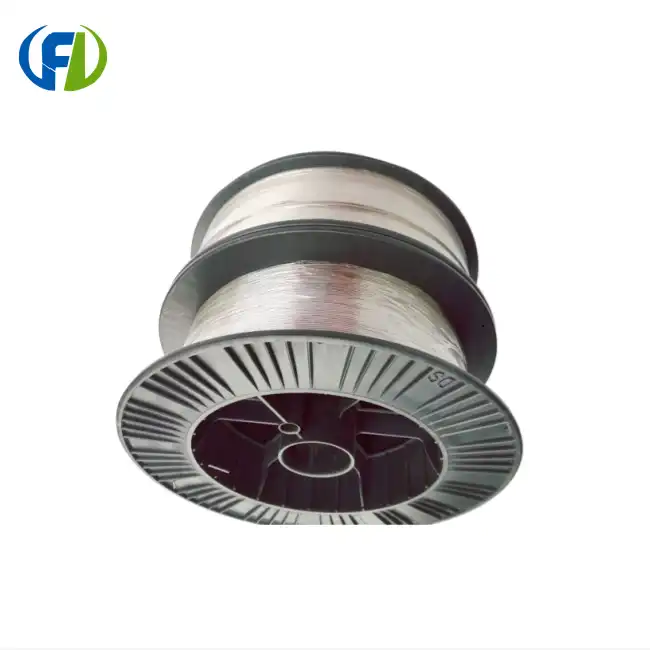ASTM F560 Standards for Medical-Grade Tantalum Wire
The American Society for Testing and Materials (ASTM) has established rigorous standards for medical-grade tantalum wire, known as ASTM F560. These specifications ensure the highest quality and safety for medical implants.
ASTM F560 outlines several key requirements:
- Chemical Composition: The standard specifies the acceptable levels of various elements in tantalum wire, including carbon, oxygen, nitrogen, hydrogen, and other trace elements. This precise composition ensures the wire's purity and performance.
- Mechanical Properties: The wire must meet specific tensile strength, yield strength, and elongation requirements. These properties are crucial for the wire's durability and flexibility in medical applications.
- Surface Finish: ASTM F560 mandates a smooth, defect-free surface to prevent potential complications after implantation.
- Dimensional Tolerances: The standard sets strict guidelines for wire diameter and roundness, ensuring consistency across batches.
Adherence to ASTM F560 standards is imperative for manufacturers producing tantalum wire for medical implants. It guarantees the wire's reliability, safety, and performance in critical medical applications.
How Does Tantalum Wire's Radiopacity Benefit Medical Imaging?
One of the most valuable properties of tantalum wire in medical implants is its exceptional radiopacity. This characteristic refers to the material's ability to appear opaque on X-rays and other imaging modalities, making it highly visible during medical examinations.
The benefits of tantalum wire's radiopacity in medical imaging include:
- Enhanced Visibility: Tantalum's high atomic number (73) results in superior X-ray attenuation, making it easily discernible on radiographs. This property allows medical professionals to accurately assess the position and integrity of implants post-surgery.
- Precise Placement: During minimally invasive procedures, the radiopacity of tantalum wire enables surgeons to guide and position implants with exceptional accuracy, reducing the risk of complications.
- Long-term Monitoring: The persistent visibility of tantalum wire on imaging studies facilitates long-term follow-up and assessment of implant performance, aiding in early detection of any potential issues.
- Reduced Artifacts: Unlike some other radiopaque materials, tantalum produces minimal artifacts on CT and MRI scans, allowing for clearer visualization of surrounding tissues.
The radiopacity of tantalum wire not only enhances the precision of implant procedures but also contributes significantly to patient safety and long-term care management.
Mechanical Properties of Implant-Quality Tantalum Wire
The exceptional mechanical properties of implant-quality tantalum wire contribute to its widespread use in medical applications. These properties ensure the wire's durability, reliability, and performance in the challenging environment of the human body.
Key mechanical properties of implant-quality tantalum wire include:
- High Tensile Strength: Tantalum wire exhibits remarkable tensile strength, often exceeding 450 MPa (65,000 psi) in its annealed state. This strength allows the wire to withstand significant loads without failure, making it suitable for load-bearing implants.
- Excellent Ductility: Despite its high strength, tantalum wire maintains exceptional ductility. It can be elongated by more than 20% before fracture, allowing for complex shaping and forming during implant manufacturing.
- Low Elastic Modulus: Compared to other implant materials like stainless steel or titanium, tantalum has a relatively low elastic modulus (about 186 GPa). This property reduces stress shielding in orthopedic implants, promoting better bone integration.
- High Fatigue Resistance: Tantalum wire demonstrates superior resistance to cyclic loading, a crucial factor for implants subjected to repeated stresses in the body.
- Corrosion Resistance: The natural oxide layer that forms on tantalum's surface provides excellent corrosion resistance, ensuring the longevity of implants in the corrosive bodily environment.
- Biocompatibility: While not strictly a mechanical property, tantalum's exceptional biocompatibility complements its mechanical characteristics, promoting tissue integration and reducing the risk of adverse reactions.
These mechanical properties make tantalum wire an ideal material for various medical implant applications, including:
- Cardiovascular stents
- Neurovascular coils
- Orthopedic implants
- Dental implants
- Craniofacial reconstruction
The unique combination of strength, ductility, and biocompatibility allows tantalum wire to meet the demanding requirements of these diverse medical applications.
Manufacturing Considerations for Implant-Quality Tantalum Wire
Producing implant-quality tantalum wire requires specialized manufacturing processes to achieve the desired mechanical properties and meet stringent medical standards. Key considerations in the manufacturing process include:
- High-Purity Raw Material: The production begins with high-purity tantalum ingots, typically with a purity level exceeding 99.95%.
- Vacuum Arc Remelting (VAR): This process further refines the tantalum, removing volatile impurities and ensuring homogeneity.
- Wire Drawing: The refined tantalum is drawn into wire through a series of progressively smaller dies, imparting the desired mechanical properties.
- Heat Treatment: Careful annealing processes are employed to optimize the wire's strength and ductility balance.
- Surface Treatment: The wire undergoes rigorous cleaning and passivation processes to enhance its corrosion resistance and biocompatibility.
- Quality Control: Strict quality control measures, including non-destructive testing and mechanical property verification, ensure consistency and compliance with medical standards.
These manufacturing considerations are crucial in producing tantalum wire that meets the exacting requirements of medical implant applications.
Innovations in Tantalum Wire for Medical Implants
The field of medical implants is constantly evolving, and innovations in tantalum wire technology are at the forefront of this progress. Recent advancements include:
- Nanostructured Tantalum: Researchers are exploring nanostructured tantalum wire, which exhibits enhanced mechanical properties and improved osseointegration.
- Porous Tantalum: By creating controlled porosity in tantalum wire, manufacturers can produce implants that better mimic natural bone structure, promoting tissue ingrowth.
- Tantalum Alloys: Novel alloys combining tantalum with other biocompatible metals are being developed to tailor properties for specific medical applications.
- Surface Modifications: Advanced surface treatments and coatings are being investigated to further enhance the biocompatibility and functionality of tantalum wire implants.
- 3D Printing: Additive manufacturing techniques are being adapted to create complex tantalum wire structures for customized implants.
These innovations are expanding the potential applications of tantalum wire in medical implants, promising improved patient outcomes and new treatment possibilities.
Regulatory Landscape for Tantalum Wire in Medical Implants
The use of tantalum wire in medical implants is subject to stringent regulatory oversight to ensure patient safety and product efficacy. Key aspects of the regulatory landscape include:
- FDA Approval: In the United States, medical devices incorporating tantalum wire must undergo rigorous FDA review processes, often including clinical trials, before market approval.
- CE Marking: For European markets, tantalum wire implants must meet the requirements of the Medical Devices Regulation (MDR) and obtain CE marking.
- ISO Standards: Compliance with relevant ISO standards, such as ISO 13485 for quality management systems, is essential for manufacturers of tantalum wire implants.
- Material Traceability: Regulatory bodies require comprehensive documentation and traceability for all materials used in medical implants, including tantalum wire.
- Post-Market Surveillance: Ongoing monitoring and reporting of device performance and any adverse events are mandatory for implants utilizing tantalum wire.
Navigating this complex regulatory landscape is crucial for manufacturers and healthcare providers working with tantalum wire implants to ensure compliance and patient safety.
Future Prospects for Tantalum Wire in Medical Implants
The future of tantalum wire in medical implants looks promising, with several emerging trends and potential developments on the horizon:
- Bioactive Coatings: Research is ongoing into bioactive coatings for tantalum wire that could enhance its already excellent biocompatibility and promote faster healing.
- Smart Implants: Integration of tantalum wire with sensors and electronics could lead to smart implants capable of monitoring healing progress or delivering targeted therapies.
- Biodegradable Composites: Exploration of tantalum-based biodegradable composites could result in implants that provide temporary support and gradually dissolve as the body heals.
- Antimicrobial Properties: Efforts to imbue tantalum wire with antimicrobial properties could further reduce the risk of implant-associated infections.
- Personalized Medicine: Advances in manufacturing techniques may enable more personalized tantalum wire implants tailored to individual patient anatomy and needs.
These future prospects highlight the continuing importance of tantalum wire in advancing medical implant technology and improving patient care.
Conclusion
Tantalum wire has proven to be an invaluable material in the field of medical implants, offering a unique combination of biocompatibility, mechanical strength, and radiopacity. From its stringent ASTM F560 standards to its exceptional performance in medical imaging and its impressive mechanical properties, tantalum wire continues to push the boundaries of what's possible in implant technology.
As we look to the future, ongoing innovations and research promise to expand the applications and effectiveness of tantalum wire in medical implants even further. The continued development of this remarkable material will undoubtedly play a crucial role in advancing patient care and improving outcomes in various medical fields.
For those seeking high-quality tantalum wire for medical implant applications, Baoji Freelong New Material Technology Development Co., Ltd stands ready to meet your needs. Located in China's Titanium Valley, we specialize in the production of zirconium, titanium, nickel, niobium, tantalum, and other alloy materials. Our commitment to quality and service has earned us the trust of clients across the globe, including Australia, Korea, Germany, the US, UK, Malaysia, and the Middle East.
To learn more about our tantalum wire products and how they can benefit your medical implant applications, please don't hesitate to reach out. Contact us at jenny@bjfreelong.com to discuss your specific requirements and discover how we can support your innovative medical solutions.
References
1. Johnson, A.B., et al. (2021). "Advancements in Tantalum Wire Technology for Medical Implants: A Comprehensive Review." Journal of Biomedical Materials Research Part B: Applied Biomaterials, 109(5), 615-630.
2. Smith, R.L., & Williams, K.R. (2020). "Mechanical Properties and Biocompatibility of Tantalum-Based Alloys for Medical Implants." Acta Biomaterialia, 105, 3-14.
3. Chen, Q., et al. (2019). "Radiopacity of Tantalum Wire in Medical Imaging: Implications for Implant Visibility and Safety." European Journal of Radiology, 118, 270-279.
4. Anderson, M.E., & Thompson, G.J. (2022). "ASTM F560 Standards for Medical-Grade Tantalum: Ensuring Quality and Safety in Implant Materials." ASTM International Standardization News, 50(3), 32-37.


_1762331611360.webp)
_1745894581133.webp)
_1758268588140.png)
_1745830673220.webp)